Inshore Fisheries Research Section
Red Drum - Scientific Catch-and-Release Studies
Large Hook Study
(adult red drum in deep water)For this study, non-offset circle hooks and J-hooks were baited with frozen bait and placed on short longline gangions. Longline gear was used both to eliminate differences in angler experience while assessing hook mortality.
Offset circle hooks were not used for this study because they are rarely used by anglers targeting red drum.
As in the previous study, the line was cut and the hook left in place if the point of the hook penetrated below the crushing plates in the back of the throat.
All fish hooked somewhere other than the jaw (i.e. gill, gut, throat, etc.) were transported to SCDNR-MRRI and held for 48 hours to determine mortality. All jaw-hooked fish were released immediately.
Non-lip hooked fish were held in 12-ft. diameter, 3-ft. deep tanks. Fish that survived the 48-hour holding period were tagged and returned to the site of capture.
Results
167 total adult red drum were captured.
107 fish were caught on non-offset circle hooks.
60 were caught on J-hooks.
(The same total number of each type of hook was set.)
Injuries to the adult fish were slightly more varied than the juveniles. However, almost all fish that died bled out within a few hours.
| Most adult red drum that died swallowed the hook into their stomachs. The hook penetrated the stomach wall and pierced the liver or some other vital organ. These fish bled out within a few hours. | 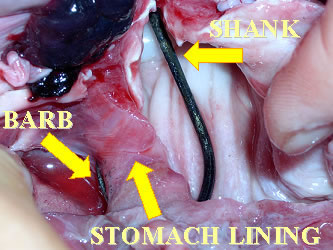 |
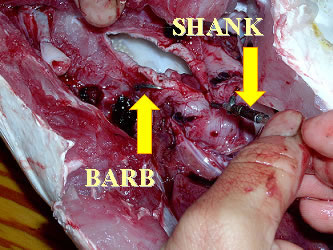 |
|
| This fish looked like it was hooked perfectly in the corner of the jaw. However, it came aboard the vessel dead. The fish was dissected and a small hook, possibly the type used for whiting or black seabass fishing, was found penetrating the stomach wall. | 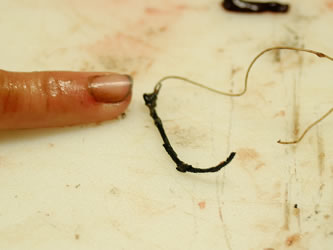 |
A large amount of old, coagulated blood was found in the body cavity as well. We assumed that the fish was unable to endure the stress of another capture after sustaining previous injuries. The adult red drum shown in this picture was brought back and held at MRRI because it looked like the hook had penetrated some gill tissue. The fish died within 36 hours. |
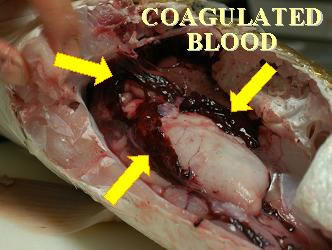 |
| When dissecting, we found that the liver had become extremely nectrotic. We also found a large hole in the stomach. It seems that at some point a hook had penetrated the stomach wall and ripped out. The hole in the stomach had allowed stomach acid to flow into the body cavity. This weakened the liver and other organs, and the fish died. | 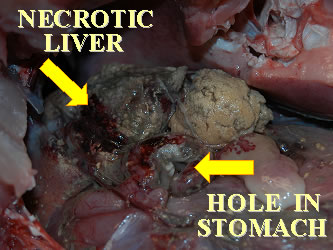 |
Conclusion
J-hooks gut-hooked the most fish in both the juvenile and adult red drum studies.
Despite the fact that offset circle hooks gut-hooked an intermediate number of fish, the largest percentage of these fish died as a result of hooking injuries.
Non-offset circle hooks gut-hooked the least number of juvenile and adult fish. In the adult study, these hooks also caught nearly 2 times as many fish as J-hooks.
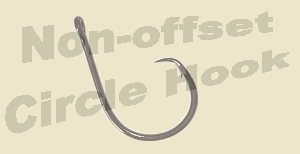
Catch-and-release fishing only helps preserve our fish populations when those fish survive. Through this study, we learned the non-offset circle hook is the best hook to use when you release some of your red drum.

This project was funded by a grant from the Cooperative Research Program of the National Marine Fisheries Service Southeast Regional Office.
